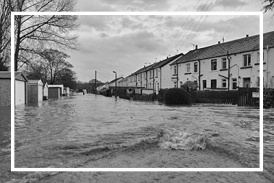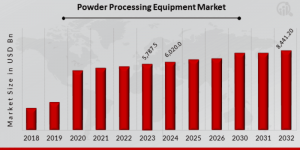Powder Processing Equipment Market Projected to Reach Significant Growth with 4.2% CAGR by 2032 | Kemutec, Sollich UK
Powder Processing Equipment Market grows with demand for advanced materials in pharmaceuticals, chemicals, and manufacturing sectors.
Overview of the Powder Processing Equipment Market
The powder processing equipment market plays a crucial role in numerous industries such as chemicals, pharmaceuticals, food processing, minerals, and metallurgy, among others. This equipment is designed to process and manage powder particles for various applications such as mixing, grinding, classification, and agglomeration.
The increasing demand for high-performance powder processing solutions across various sectors, driven by evolving consumer preferences and technological advancements, has led to significant growth in the market. In this article, we explore the trends, dynamics, drivers, and outlook of the powder processing equipment market.
Get Free Sample PDF Brochure: https://www.marketresearchfuture.com/sample_request/9576
Key Companies in the Powder Processing Equipment market include
Hosokawa Micron Corporation
Baker Perkins Limited
Syntegon Technology GmbH
Hänsel Processing GmbH
Sollich UK Ltd
Dongsun Powder Processing Equipment Co. Ltd
Sanovo Technology Group
Powder Process-Solutions
Bepex International LLC
British Rema
Classifier Milling Systems
Powder Systems Corporation
Charles Ross & Son Company
Guilin Hongcheng Mining Equipment Manufacture Co. Ltd
Kemutec
Market Trends Highlights
One of the prominent trends in the powder processing equipment market is the growing demand for automation and smart technologies. Industrial automation systems such as robotics and artificial intelligence (AI) are increasingly being integrated into powder processing operations. These technologies allow for real-time monitoring, data collection, and predictive maintenance, ensuring greater efficiency and reducing human intervention. The integration of Industry 4.0 technologies helps improve overall operational efficiency, reduce downtime, and increase productivity, driving the adoption of advanced powder processing equipment.
Another notable trend is the rising preference for environmentally friendly and energy-efficient equipment. With increasing environmental concerns and regulatory pressures, companies are focusing on sustainable manufacturing processes. The demand for energy-efficient powder processing equipment is growing as businesses strive to meet stringent environmental regulations and reduce operational costs.
Market Drivers
Growth in End-User Industries: Industries such as pharmaceuticals, food processing, chemicals, and mining are driving the demand for powder processing equipment. For instance, the pharmaceutical industry requires precision in powder handling for active pharmaceutical ingredients (APIs) and excipients. Similarly, the food processing industry uses powders for making ingredients like milk powder, cocoa, and flavor additives. This growth in various end-user sectors contributes to the demand for more advanced powder processing solutions.
Technological Advancements: The continuous evolution of technology in powder processing equipment is a significant driver. With the development of more efficient mills, mixers, and classifiers, companies can process powders more quickly and with greater consistency. The integration of automated control systems and AI in powder processing equipment improves the overall quality and productivity of manufacturing processes.
Rising Demand for Customization: Powder processing equipment is increasingly required to accommodate custom solutions, especially in industries like pharmaceuticals and chemicals. Companies need equipment that can process materials with varying characteristics, such as different particle sizes or moisture contents. This growing need for customization is propelling the market, as manufacturers focus on providing flexible and adaptable powder processing systems.
Buy Now Premium Research Report: https://www.marketresearchfuture.com/checkout?currency=one_user-USD&report_id=9576
Market Restraints
High Initial Investment: One of the primary challenges in the powder processing equipment market is the high initial investment required for purchasing and installing advanced processing systems. Smaller companies or startups may find it difficult to afford such equipment, which could limit market growth.
Complex Maintenance and Operational Costs: While powder processing equipment is efficient, it often requires regular maintenance to function optimally. Maintenance can be costly, especially if specialized parts or technicians are needed. Additionally, the operational costs associated with running large-scale powder processing equipment, including energy costs, can be a burden for some manufacturers.
Fluctuating Raw Material Costs: Powder processing equipment often deals with raw materials that can be affected by market fluctuations, which in turn affects the cost of processing. Price volatility of raw materials such as chemicals, minerals, or food products can lead to unpredictable manufacturing costs, making it difficult for companies to plan effectively.
Market Segmentation
The powder processing equipment market can be segmented based on the following factors:
Type of Equipment:
Mills: Used for grinding and reducing materials to fine powders. The most common types include ball mills, hammer mills, and impact mills.
Mixers: Equipment designed to blend powders and other ingredients to ensure uniformity. Types include ribbon blenders, V-blenders, and paddle mixers.
Classifiers: Machines used for separating powders based on particle size.
Dryers: Used for drying powder-based materials to remove moisture.
Agglomerators: Machines that form particles into larger, uniform granules.
End-User Industry:
Pharmaceuticals: For processing API powders and excipients.
Food & Beverages: For the production of milk powder, flavoring agents, and other powdered ingredients.
Chemicals: For processing raw chemical materials into fine powders.
Mining: For fine powder production from minerals.
Others: Such as cosmetics, ceramics, and plastics.
Browse In-depth Market Research Report: https://www.marketresearchfuture.com/reports/powder-processing-equipment-market-9576
Future Trends
As the powder processing equipment market continues to evolve, several trends are expected to shape its future:
Integration of Artificial Intelligence and IoT: The future of powder processing equipment will see more widespread use of artificial intelligence (AI) and the Internet of Things (IoT). These technologies will enable more efficient processing, real-time monitoring, and predictive maintenance, leading to reduced downtime and optimized production.
Sustainability and Green Manufacturing: Manufacturers are increasingly focusing on sustainability. Future trends will likely see more energy-efficient and eco-friendly powder processing equipment that reduces waste and minimizes environmental impact. Green manufacturing processes will become an essential part of market growth.
Customization and Automation: Demand for highly customized and automated powder processing systems will continue to rise. Companies will seek solutions that not only meet specific needs but also enhance the efficiency and flexibility of production lines.
More Related Reports:
Medical Facility Lighting System Market: https://www.marketresearchfuture.com/reports/medical-facility-lighting-system-market-23464
Manometers Market: https://www.marketresearchfuture.com/reports/manometers-market-23463
Mini Skid Steer Rental Market; https://www.marketresearchfuture.com/reports/mini-skid-steer-rental-market-23469
Multi Component Injection Moulding Technology Market: https://www.marketresearchfuture.com/reports/multi-component-injection-moulding-technology-market-23471
NDT Inspection Service Market: https://www.marketresearchfuture.com/reports/ndt-inspection-service-market-23473
Piston Ram Valves Market: https://www.marketresearchfuture.com/reports/piston-ram-valves-market-23478
Nylon Monofilament Market: https://www.marketresearchfuture.com/reports/nylon-monofilament-market-23476
Advancing Indiana’s Independent Auto Industry
JOLT Phone App Redefines Android Calling Experience with Next-Gen Personalization Features
EvolX Games Announces Ludaro: A Roguelike Deck-Building Dice Game Inspired by Classic Ludo
Kalendarium
Więcej ważnych informacji
 Jedynka Newserii
Jedynka Newserii

 Jedynka Newserii
Jedynka Newserii

Prawo

UE lepiej przygotowana na reagowanie na klęski żywiołowe. Od czasu powodzi w Polsce pojawiło się wiele usprawnień
Na tereny dotknięte ubiegłoroczną powodzią od rządu trafiło ponad 4 mld zł. Pierwsze formy wsparcia, w tym zasiłki, pomoc materialna czy wsparcie dla przedsiębiorców, pojawiły się już w pierwszych dniach od wystąpienia kataklizmu. Do Polski ma też trafić 5 mld euro z Funduszu Spójności UE na likwidację skutków powodzi. Doświadczenia ostatnich lat powodują, że UE jest coraz lepiej przygotowana, by elastycznie reagować na występujące klęski żywiołowe.
Prawo
Rzecznik MŚP: Obniżenie składki zdrowotnej to nie jest szczyt marzeń. Ideałem byłby powrót do tego, co było przed Polskim Ładem

Podczas najbliższego posiedzenia, które odbędzie się 23 i 24 kwietnia, Senat ma się zająć ustawą o świadczeniach opieki zdrowotnej finansowanych ze środków publicznych. Zakłada ona korzystne zmiany w składkach zdrowotnych płaconych przez przedsiębiorców. Rzecznik MŚP apeluje do izby wyższej i prezydenta o przyjęcie i podpisanie nowych przepisów. Pojawiają się jednak głosy, że uprzywilejowują one właścicieli firm względem pracowników, a ponadto nie podlegały uzgodnieniom, konsultacjom i opiniowaniu.
Handel
Konsumpcja jaj w Polsce rośnie. Przy zakupie Polacy zwracają uwagę na to, z jakiego chowu pochodzą

Zarówno spożycie, jak i produkcja jaj w Polsce notują wzrosty. Znacząca większość konsumentów przy zakupie jajek zwraca uwagę na to, czy pochodzą one z chowu klatkowego. Polska jest jednym z liderów w produkcji i eksporcie jajek w UE, ale ma też wśród nich największy udział kur w chowie klatkowym. Oczekiwania konsumentów przyczyniają się powoli do zmiany tych statystyk.
Partner serwisu
Szkolenia

Akademia Newserii
Akademia Newserii to projekt, w ramach którego najlepsi polscy dziennikarze biznesowi, giełdowi oraz lifestylowi, a także szkoleniowcy z wieloletnim doświadczeniem dzielą się swoją wiedzą nt. pracy z mediami.



![Dramatyczna sytuacja w opiece długoterminowej. Kolejki oczekujących są coraz dłuższe [DEPESZA]](https://www.newseria.pl/files/1097841585/opieka-nfz-still-1,w_85,_small.jpg)





.gif)

 |
| |
| |
|